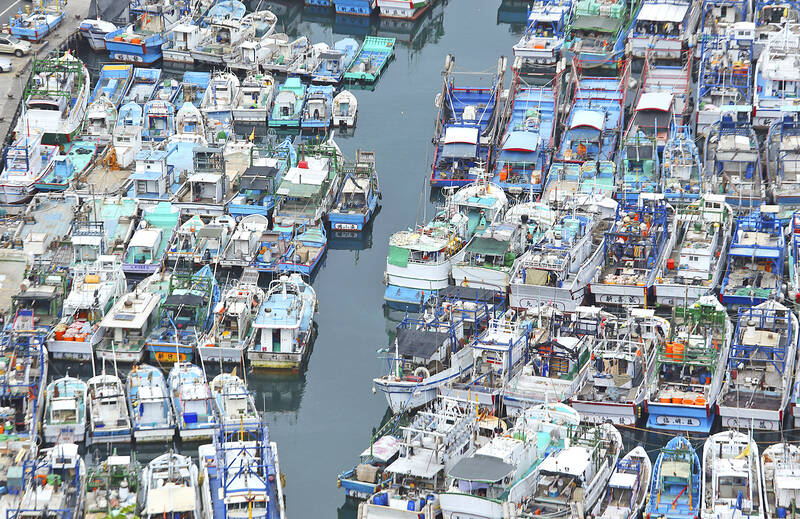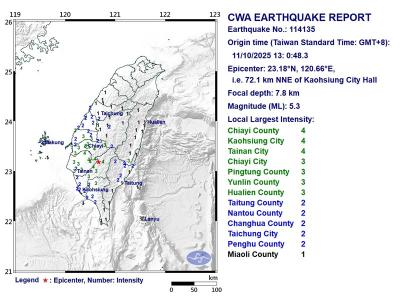The Fisheries Agency updated the US Department of Labor on its efforts to eliminate forced labor on Taiwanese fishing vessels at a meeting in Washington on Friday, it said yesterday.
Taiwanese seafood products were added to the US’ List of Goods Produced by Child Labor or Forced Labor in 2020, and the Fisheries Agency said it was hoping Washington would remove them from the next list, which is expected to be published later this month.
The labor department’s decision in 2020 came after 19 non-governmental organizations sent a letter to the department saying that “forced labor on Taiwanese longline fishing vessels continues unabated with little to no consequences.”

Photo: Wally Santana, AP
A delegation led by Fisheries Agency Director-General Chang Chih-sheng (張致盛) held a meeting with representatives from the department’s Bureau of International Labor Affairs on Friday, the agency said in a statement.
The meeting was titled the Taiwan-US Bilateral Consultation on Fishery Labor Rights and Benefits, the agency said.
The delegation shared Taiwan’s progress in improving fishers’ human rights, Fisheries Agency Deputy Director-General Lin Kuo-ping (林國平) said in Taipei yesterday.
The agency said it told US officials that the Executive Yuan on May 20 approved its Action Plan for Fisheries and Human Rights.
The action plan covers major strategies for bolstering labor recruitment processes and the management of foreign-flagged fishing vessels and recruitment agents, as well as improving the monitoring and management of living and working conditions on longline fishing vessels, the agency said.
To be taken off the department’s list, Taiwan would be expected to increase the number of labor inspectors and inspections, and implement additional measures to safeguard the welfare of fishers, it said.
The US hopes that the prevalence of forced labor can be reduced by implementing social protection programs and establishing migrant fisher unions, itthe agency said.
The delegation also visited Greenpeace’s US branch to convey Taiwan’s support for safeguarding the rights of migrant fishers, it said.
Greenpeace was one of the first to draw wider attention to claims of labor rights violations on Taiwanese-flagged longline fishing vessels in a 2019 report titled Seabound: The Journey to Modern Slavery on the High Seas.
Meanwhile, the agency released a revision to the Regulations on the Authorization and Management of Overseas Employment of Foreign Crew Members (境外僱用非我國籍船員許可及管理辦法), saying that the minimum monthly wage was raised from US$450 to US$550, while the insurance compensation limit for deceased crew members was increased from NT$1 million to NT$1.5 million (US$32,563 to US$48,844) and the maximum pay-as-you-go medical insurance compensation limit was set at NT$300,000.
The standard for minimum daily rest hours was also amended to be in line with the ILO C188 Convention for migrant fishers, the agency said.

The Central Weather Administration (CWA) today issued a sea warning for Typhoon Fung-wong effective from 5:30pm, while local governments canceled school and work for tomorrow. A land warning is expected to be issued tomorrow morning before it is expected to make landfall on Wednesday, the agency said. Taoyuan, and well as Yilan, Hualien and Penghu counties canceled work and school for tomorrow, as well as mountainous district of Taipei and New Taipei City. For updated information on closures, please visit the Directorate-General of Personnel Administration Web site. As of 5pm today, Fung-wong was about 490km south-southwest of Oluanpi (鵝鑾鼻), Taiwan's southernmost point.

Almost a quarter of volunteer soldiers who signed up from 2021 to last year have sought early discharge, the Legislative Yuan’s Budget Center said in a report. The report said that 12,884 of 52,674 people who volunteered in the period had sought an early exit from the military, returning NT$895.96 million (US$28.86 million) to the government. In 2021, there was a 105.34 percent rise in the volunteer recruitment rate, but the number has steadily declined since then, missing recruitment targets, the Chinese-language United Daily News said, citing the report. In 2021, only 521 volunteers dropped out of the military, the report said, citing

A magnitude 5.3 earthquake struck Kaohsiung at 1pm today, the Central Weather Administration said. The epicenter was in Jiasian District (甲仙), 72.1km north-northeast of Kaohsiung City Hall, at a depth of 7.8km, agency data showed. There were no immediate reports of damage. The earthquake's intensity, which gauges the actual effects of a temblor, was highest in Kaohsiung and Tainan, where it measured a 4 on Taiwan's seven-tier intensity scale. It also measured a 3 in parts of Chiayi City, as well as Pingtung, Yunlin and Hualien counties, data showed.

Nearly 5 million people have signed up to receive the government’s NT$10,000 (US$322) universal cash handout since registration opened on Wednesday last week, with deposits expected to begin tomorrow, the Ministry of Finance said yesterday. After a staggered sign-up last week — based on the final digit of the applicant’s national ID or Alien Resident Certificate number — online registration is open to all eligible Taiwanese nationals, foreign permanent residents and spouses of Taiwanese nationals. Banks are expected to start issuing deposits from 6pm today, the ministry said. Those who completed registration by yesterday are expected to receive their NT$10,000 tomorrow, National Treasury